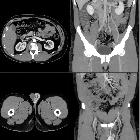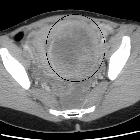ovarian vein thrombosis





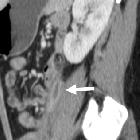






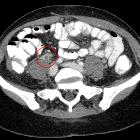
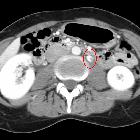
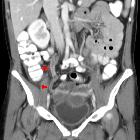











Ovarian vein thrombosis (actually most often thrombophlebitis) occurs most commonly in postpartum patients and can result in pulmonary emboli. A presentation is usually with acute pelvic pain in the postpartum period, then termed puerperal ovarian vein thrombosis or postpartum ovarian vein thrombosis.
Epidemiology
The estimated incidence of postpartum ovarian vein thrombosis is ~1:600-1:2000 deliveries .
Clinical presentation
The dominant symptom of clinically significant ovarian vein thrombosis is pain in the lower abdomen / right lower quadrant pain and fever, which usually appears approximately ten days postpartum with no response to antibiotic treatment. There may occasionally be a palpable mass felt in the right iliac fossa.
Pathology
Location: laterality
- in ~80-90% of cases, the right ovarian vein is involved, possibly due to retrograde flow in the left vein preventing stasis and ascending infection
- ~14% of cases can have bilateral involvement
- ~6% of cases involve the left ovarian vein only
Radiographic features
Ultrasound
May be difficult if there is overlying bowel gas and the ovarian vein may not be identified in every case .
- tubular/serpiginous hypoechoic structure in the adnexa adjacent to the ovarian artery
- if the ovarian vein is identifiable, the absence of Doppler flow can be a diagnostic feature
CT
- tubular structure with an enhancing wall and low-attenuation thrombus in the expected location of the ovarian vein
- remember that
- the right ovarian vein drains to the inferior vena cava
- the left ovarian vein drains to the left renal vein
- remember that
Treatment and prognosis
Appropriate treatment consists of a combination of anticoagulation and antibiotics. However, mortality rates of up to 5% have been observed, making the diagnosis an important one to consider in the postpartum patient.
Complications
Differential diagnosis
Considerations include:
- hydroureter
- acute appendicitis: can be differential for the clinical presentation
Siehe auch:
- Nussknacker-Syndrom
- Appendizitis
- pelvines Kongestionssyndrom
- Vena ovarica
- Ovarialvenenthrombose rechts
- akuter Beckenschmerz
und weiter:

 Assoziationen und Differentialdiagnosen zu Ovarialvenenthrombose:
Assoziationen und Differentialdiagnosen zu Ovarialvenenthrombose:

